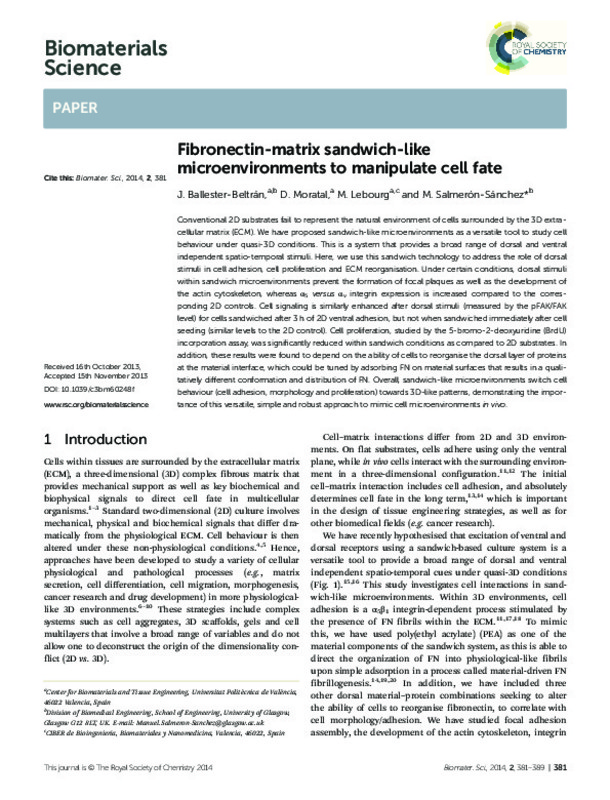JavaScript is disabled for your browser. Some features of this site may not work without it.
Buscar en RiuNet
Listar
Mi cuenta
Estadísticas
Ayuda RiuNet
Admin. UPV
Fibronectin-matrix sandwich-like microenvironments to manipulate cell fate
Mostrar el registro sencillo del ítem
Ficheros en el ítem
| dc.contributor.author | Ballester Beltrán, José
|
es_ES |
| dc.contributor.author | Moratal Pérez, David
|
es_ES |
| dc.contributor.author | Lebourg, Myriam Madeleine
|
es_ES |
| dc.contributor.author | Salmerón Sánchez, Manuel
|
es_ES |
| dc.date.accessioned | 2016-06-21T07:40:37Z | |
| dc.date.available | 2016-06-21T07:40:37Z | |
| dc.date.issued | 2014 | |
| dc.identifier.issn | 2047-4830 | |
| dc.identifier.uri | http://hdl.handle.net/10251/66230 | |
| dc.description.abstract | [EN] Conventional 2D substrates fail to represent the natural environment of cells surrounded by the 3D extracellular matrix (ECM). We have proposed sandwich-like microenvironments as a versatile tool to study cell behaviour under quasi-3D conditions. This is a system that provides a broad range of dorsal and ventral independent spatio-temporal stimuli. Here, we use this sandwich technology to address the role of dorsal stimuli in cell adhesion, cell proliferation and ECM reorganisation. Under certain conditions, dorsal stimuli within sandwich microenvironments prevent the formation of focal plaques as well as the development of the actin cytoskeleton, whereas alpha(5) versus alpha(v) integrin expression is increased compared to the corresponding 2D controls. Cell signaling is similarly enhanced after dorsal stimuli (measured by the pFAK/FAK level) for cells sandwiched after 3 h of 2D ventral adhesion, but not when sandwiched immediately after cell seeding (similar levels to the 2D control). Cell proliferation, studied by the 5-bromo-2-deoxyuridine (BrdU) incorporation assay, was significantly reduced within sandwich conditions as compared to 2D substrates. In addition, these results were found to depend on the ability of cells to reorganise the dorsal layer of proteins at the material interface, which could be tuned by adsorbing FN on material surfaces that results in a qualitatively different conformation and distribution of FN. Overall, sandwich-like microenvironments switch cell behaviour (cell adhesion, morphology and proliferation) towards 3D-like patterns, demonstrating the importance of this versatile, simple and robust approach to mimic cell microenvironments in vivo. | es_ES |
| dc.description.sponsorship | The support from ERC through HealInSynergy (306990) and the FPU program AP2009-3626 are acknowledged. | |
| dc.language | Inglés | es_ES |
| dc.publisher | Royal Society of Chemistry | es_ES |
| dc.relation.ispartof | Biomaterials Science | es_ES |
| dc.rights | Reconocimiento (by) | es_ES |
| dc.subject | Focal adhesion kinase | es_ES |
| dc.subject | Shape | es_ES |
| dc.subject | 3RD-Dimension | es_ES |
| dc.subject | Migration | es_ES |
| dc.subject | Motility | es_ES |
| dc.subject | Differentiation | es_ES |
| dc.subject | Biomaterials | es_ES |
| dc.subject | Cytoskeleton | es_ES |
| dc.subject | Morphology | es_ES |
| dc.subject | Growth | es_ES |
| dc.subject.classification | TERMODINAMICA APLICADA (UPV) | es_ES |
| dc.subject.classification | FISICA APLICADA | es_ES |
| dc.subject.classification | TECNOLOGIA ELECTRONICA | es_ES |
| dc.title | Fibronectin-matrix sandwich-like microenvironments to manipulate cell fate | es_ES |
| dc.type | Artículo | es_ES |
| dc.identifier.doi | 10.1039/C3BM60248F | |
| dc.relation.projectID | info:eu-repo/grantAgreement/EC/FP7/306990/EU/Material-driven Fibronectin Fibrillogenesis to Engineer Synergistic Growth Factor Microenvironments/ | en_EN |
| dc.relation.projectID | info:eu-repo/grantAgreement/MECD//AP2009-3626/ES/AP2009-3626/ | es_ES |
| dc.rights.accessRights | Abierto | es_ES |
| dc.contributor.affiliation | Universitat Politècnica de València. Centro de Biomateriales e Ingeniería Tisular - Centre de Biomaterials i Enginyeria Tissular | es_ES |
| dc.contributor.affiliation | Universitat Politècnica de València. Departamento de Física Aplicada - Departament de Física Aplicada | es_ES |
| dc.contributor.affiliation | Universitat Politècnica de València. Departamento de Termodinámica Aplicada - Departament de Termodinàmica Aplicada | es_ES |
| dc.contributor.affiliation | Universitat Politècnica de València. Departamento de Ingeniería Electrónica - Departament d'Enginyeria Electrònica | es_ES |
| dc.description.bibliographicCitation | Ballester Beltrán, J.; Moratal Pérez, D.; Lebourg, MM.; Salmerón Sánchez, M. (2014). Fibronectin-matrix sandwich-like microenvironments to manipulate cell fate. Biomaterials Science. 2(3):381-389. https://doi.org/10.1039/C3BM60248F | es_ES |
| dc.description.accrualMethod | S | es_ES |
| dc.relation.publisherversion | http://dx.doi.org/10.1039/c3bm60248f | es_ES |
| dc.description.upvformatpinicio | 381 | es_ES |
| dc.description.upvformatpfin | 389 | es_ES |
| dc.type.version | info:eu-repo/semantics/publishedVersion | es_ES |
| dc.description.volume | 2 | es_ES |
| dc.description.issue | 3 | es_ES |
| dc.relation.senia | 278453 | es_ES |
| dc.identifier.eissn | 2047-4849 | |
| dc.contributor.funder | European Commission | |
| dc.contributor.funder | Ministerio de Educación, Cultura y Deporte | es_ES |








